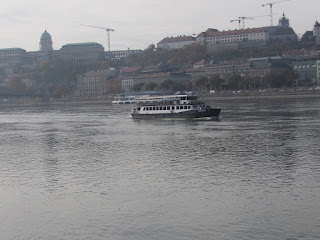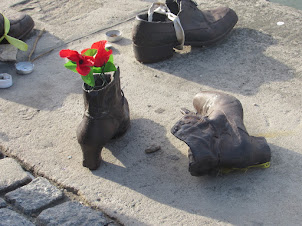We were having dinner on cruise boat on the Danube River when suddenly the Parliament Building came into view like a beautiful, heavenly vision. It was all lit up and aroused several gasps of awe among us. A couple days later we would tour the building and be dazzled even more by the elaborate furnishings and huge rooms. Clearly this building was meant to impress. And we were duly impressed!
The building is situated on Kossuth Square in the Pest side of the city, the eastern bank of the Danube. The neo-Gothic building opened in 1902.
Imre Steindl (center with beard) was the chief architect of the Gothic Revival building which has a symmetrical façade and a central dome.The interior is also symmetrical with two identical parliament halls on opposing sides of the building. One of the two halls is used today for the unicameral Hungarian National Assembly; the other is for ceremonies, conferences, and guided tours.
The interior includes 10 courtyards, 13 passenger and freight elevators, 27 gates, 29 staircases and 691 rooms (which include more than 200 offices). Its height is 96 meters (315 ft), which refers to the nation's millennium celebration of 1896 commemorating the conquest of the later Kingdom of Hungary in 896.
About 100,000 people were involved in the building's construction that used 40 million bricks, half a million precious stones, and 88 pounds of gold.
The National Assembly's hall
During the time of the People's Republic of Hungary, a red star was perched on the top of the dome signifying its communist rule. This star is the last one to sit on the dome. It was removed in 1990 after the fall of communism and the USSR. The Hungarian Republic was declared on October 23, 1989.
The Parliament Building faces Kossuth Square.
Lajos Kossuth (1802-94) was a Hungarian nobleman, lawyer, journalist, politician, statesman, and governor-president of the Kingdom of Hungary during the revolution of 1848. He was widely honored during his lifetime, including in Great Britain and the United States, as a freedom fighter and bellwether of democracy in Europe.
The Hungarian Revolution of 1848 was among the European Revolutions of that era (eg., France and Belgium) and closely linked to other revolutions in the Habsburg areas.
Although the revolution failed, it is one of the most significant
events in Hungary's history and national identity. Among its policies were democratic elections, suffrage, a democratic Parliament, and the erasure of nobility's privileges.
The Lajos Kossuth Memorial, commemorates the leader of the 1848 Revolution in Kossuth Square just outside the Parliament Building.
The Holy Crown of Hungary is displayed in the central hall (since 2000). Two military guards are posted on both sides of the crown, which is encased in glass. The area is very quiet and respectful. Photos are not allowed so this one came from Wikipedia.
A magnificent grand staircase at the riverfront entrance of the Parliament Building. Below are decorative arches and ceilings with massive columns.


Cleaning the dome
Smoking was not allowed in the Assembly hall, so the assemblymen smoked their cigars in the corridor. When business reconvened, they left their cigars in these slots so they could take them up later.
Elaborate carpet designs
Figures stand on pedestals throughout the corridors. They represent the various jobs and statuses of the people.


The Danube River in Budapest is architectural eye candy even in foggy weather and the darkness of the night. Here are some samples with apologies for the quality of the night time photos, which were taken through the cruise boat's windows.


Fisherman’s Bastion
Fisherman's Bastion on Castle Hill provides not only spectacular views of the city of Pest (the eastern flat lands) and the Danube River, but it also illustrates how the history of this region was constantly vulnerable to invading armies. The Bastion was a fortress in Buda, west of the river. In the middle of the square sits St. Stephen on his horse.
Stephen I, also known as King Saint Stephen, was the last grand prince of the Hungarians between 997 and 1000 or 1001, and the first king of Hungary from 1000 or 1001 until his death in 1038.

Fishermen's Bastion features an elegant walkway topped with seven cone-shaped towers that symbolize the Magyar chieftains (below) who settled this part of the Carpathian Basin in the late 800s.

The 460-foot long bastion is named after the fishermen’s guild that defended this hill in the Middle Ages. Here is a remnant of the original fortress wall.
According to tradition, St. Matthias was the first church to appear on the Buda hilltop. It was founded in 1015 by Saint Stephen, King of Hungary. Historians think it was originally designed in Romanesque style, though they are not certain. The Mongols destroyed the church in 1241, and the current building was constructed afterward in the late Gothic style.
During the first Turkish invasion in 1526, the medieval roof structure and most of its equipment were destroyed, altars discarded, and walls plastered over. In 1541, the church was converted into a mosque after the Turks' final conquest of Buda. Although most other churches in the city were destroyed, this one survived because the Sultan Suleiman preserved it as a thanksgiving to Allah for his victory.
The siege of Buda (1686) was fought between the Ottoman Empire and the Holy League, a coalition of Christian European nations founded to prevent further Ottoman expansion into Europe. The Holy League retook Buda (modern day Budapest) in 78 days thus ended 150 years of Ottoman rule.
The church became the property of the Franciscans, and then of the Jesuits, who restored it in Baroque style. The Jesuits also built a huge dormitory between 1688 and 1702 and a three-story seminary. Although it was the scene of great pastoral work, the church lost almost all its medieval ornamentation.
After the conquest, the victorious soldiers of Christian Western European took revenge on the hated "heathens" and killed over 3,000 Turks. Thus, the Turkish threat was firmly embodied in the consciousness of Europe at that time, fueled by reports of Turkish atrocities against civilians and the religious attitudes of the Christian Church. Jews also suffered violence because as subjects of the Ottomans, they enjoyed greater tolerance. They also fought as allies of the Turks. Half of the 3,000 Jews of Buda were massacred, their properties looted and destroyed, and hundreds (including 6,000 Muslims) were sold as slaves or held for ransom. Three synagogues and mosques and minarets of Buda were also destroyed as well as numerous valuable books. The imperial troops buried their own dead and threw the dead bodies of the Turks and Jews into the Danube.
As a consequence of the Buda siege and another battle elsewhere, the Hungarian parliament recognized that the inheritance of the Hungarian crown had passed to the Habsburgs in November 1687.
Under the leadership of the Hapsburg king Franz Joseph I of Austria a major rebuilding effort took place between 1874 and 1896, which restored the church to its original 13th-century plan. A number of early original Gothic elements were also uncovered while architects added new motifs, such as the diamond pattern roof tiles and gargoyle-laden spire.
In the 1930s, a complete renovation of the church was begun, but World War II prevented its completion. In fact, during the Allies' 1944–45 siege of Budapest, the building was severely damaged. Here are a couple ways the church was used that led to its desecration: the Germans used the crypt as their camp kitchen, and after the war the Soviets used the sanctuary to stable their horses. The Hungarian State repaired war damage between 1950 and 1970 and the five-manual organ was restored and re-consecrated in 1984.
In 1994, an unidentified terrorist detonated an IED at the gate of the building that opens towards the Fisherman's Bastion, damaging sixteen of the church's windows.
In 1999 the church was—for the first time in its history—handed over to the Catholic Church as parish property. The state financed restoration works from 2005 to 2015.
Shoes on the Bank of the Danube River



Shoes on the Danube Bank is a memorial erected on April 16, 2005 to honor the Jews who were massacred by fascist Hungarian militia belonging to the Arrow Cross Party in Budapest during the World War II. The people were ordered to take off their shoes (shoes were valuable and could be resold), and be shot at the edge of the water so that their bodies fell into the river and were carried away. This memorial represents their shoes left behind on the bank. The memorial is almost 1,000 feet from the front of the Parliament Building.
Most of the murders took place between December 1944 and January 1945, when the Hungarian
Arrow Cross Party police took as many as 20,000 Jews from the newly-established Budapest ghetto and executed them along the river bank.

In another sad note, the newspapers reported in September 2014 that several bronze shoes were stolen from the Danube Holocaust Memorial even though "it was not immediately clear whether the theft...was an anti-Semitic act or a meaningless prank. In August 2024, the monument was again desecrated. Police presumed that the vandals were possibly unaware of the significance of the memorial.
Sources
Shoes on the Danube -- https://en.wikipedia.org/wiki/Shoes_on_the_Danube_Bank
Parliament Building -- https://en.wikipedia.org/wiki/Hungarian_Parliament_Building
Hungarian Revolution of 1848 -- https://en.wikipedia.org/wiki/Hungarian_Revolution_of_1848
Lajos Kossuth -- https://en.wikipedia.org/wiki/Lajos_Kossuth
St Mattias Church -- https://en.wikipedia.org/wiki/Matthias_Church
Siege of Buda -- https://en.wikipedia.org/wiki/Siege_of_Buda_(1686)
Fisherman's Bastion -- https://welovebudapest.com/en/venue/fishermen-s-bastion/
St Stephen -- https://en.wikipedia.org/wiki/Stephen_I_of_Hungary



































No comments:
Post a Comment